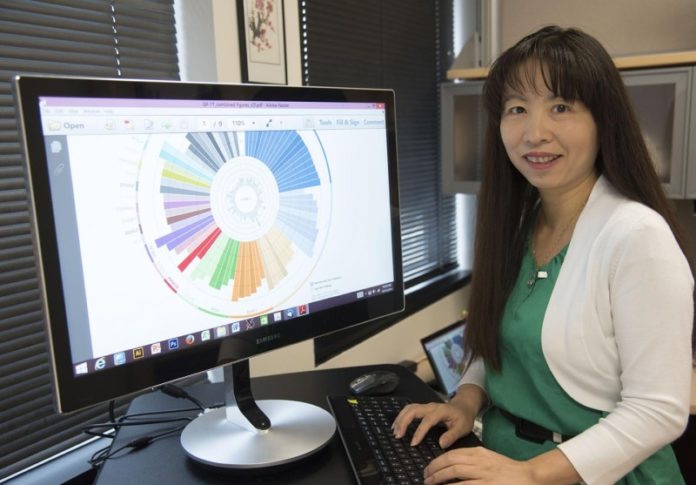
At least 2 percent of people over age 40 and 5 percent of people over 70 have mutations linked to leukemia and lymphoma in their blood cells, according to new research at Washington University School of Medicine in St. Louis.
Mutations in the body’s cells randomly accumulate as part of the aging process, and most are harmless. For some people, genetic changes in blood cells can develop in genes that play roles in initiating leukemia and lymphoma even though such people don’t have the blood cancers, the scientists report Oct. 19 in Nature Medicine.
The findings, based on blood samples from nearly 3,000 patients, don’t mean that people with these genetic mutations are destined to develop a blood cancer. In fact, the vast majority of them won’t as the incidence of blood cancers such as leukemia or lymphoma is less than 0.1 percent among the elderly.
“But it’s quite striking how many people over age 70 have these mutations,” said senior author Li Ding, PhD, of The Genome Institute at Washington University. “The power of this study lies in the large number of people we screened. We don’t yet know whether having one of these mutations causes a higher than normal risk of developing blood cancers. More research would be required to better understand that risk.”
The researchers analyzed blood samples from people enrolled in The Cancer Genome Atlas project, a massive endeavor funded by the National Cancer Institute and the National Human Genome Research Institute at the National Institutes of Health (NIH). The effort involves cataloguing the genetic errors involved in more than 20 types of cancers.
The patients whose blood was analyzed for the current study had been diagnosed with cancer but were not known to have leukemia, lymphoma or a blood disease. They ranged in age from 10 to 90 at the time of diagnosis and had donated blood and tumor samples before starting cancer treatment. Therefore, any mutations identified by the researchers would not have been associated with chemotherapy or radiation therapy, which can damage cells’ DNA.
The researchers, including Genome Institute scientists Mingchao Xie, Charles Lu, PhD, and Jiayin Wang, PhD, zeroed in on mutations that were present in the blood but not in tumor samples from the same patients. Such genetic changes in the blood would be associated with changes in stem cells that develop into blood cells, but not to the same patient’s cancer.
They looked closely at 556 known cancer genes. In 341 patients ages 40-49, fewer than 1 percent had mutations in 19 leukemia- or lymphoma-related genes. But among 475 people ages 70-79, over 5 percent did. And over 6 percent of the 132 people ages 80-89 had mutations in these genes.
The researchers noted that nine of the 19 genes were mutated repeatedly, an indicator that the changes drive or initiate the expansion of blood cells with these mutations.
This expansion of cells is clearly not leukemia or lymphoma, the researchers said. It may be a precursor to blood cancers in a small subset of patients, but the study was not designed to predict the future risk of developing these diseases.
The current study likely underestimates the percentage of people with mutations in leukemia and lymphoma genes because the researchers only were able to identify small mutations, not large structural variations or the insertions and deletions of chunks of genetic material.
Still, it would be premature for people to undergo genetic testing to see if they have mutations linked to leukemia and lymphoma as a means to predict their risk of blood cancers.
“We would not want anyone to think they should be screened for these mutations to understand their risk of leukemia or lymphoma,” said co-author and leukemia scientist Timothy Ley, MD, the Lewis T. and Rosalind B. Apple Professor of Oncology. “The ability to understand how mutations in these genes increase a person’s risk of blood cancers is a long way off, and genetic testing would be of no benefit at this time.”
If the researchers repeated the study in tens of thousands of patients and tracked the development of mutations over time, they could more accurately identify the risk of individual mutations or combinations of mutations for the development of leukemia and lymphoma. Such a study is intriguing to contemplate but would take years to complete and require considerable financial resources, Ding said.
Story Source:
The above story is based on materials provided by Washington University in St. Louis. Note: Materials may be edited for content and length.
Journal Reference:
- Mingchao Xie, Charles Lu, Jiayin Wang, Michael D McLellan, Kimberly J Johnson, Michael C Wendl, Joshua F McMichael, Heather K Schmidt, Venkata Yellapantula, Christopher A Miller, Bradley A Ozenberger, John S Welch, Daniel C Link, Matthew J Walter, Elaine R Mardis, John F Dipersio, Feng Chen, Richard K Wilson, Timothy J Ley, Li Ding. Age-related mutations associated with clonal hematopoietic expansion and malignancies. Nature Medicine, 2014; DOI: 10.1038/nm.3733
